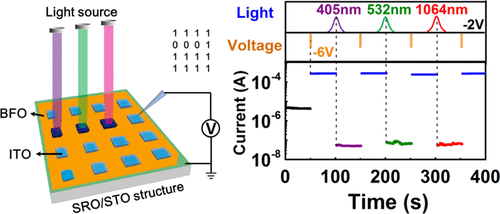当前位置:
X-MOL 学术
›
ACS Appl. Electron. Mater.
›
论文详情
Our official English website, www.x-mol.net, welcomes your
feedback! (Note: you will need to create a separate account there.)
Nonvolatile Negative Optoelectronic Memory Based on Ferroelectric Thin Films
ACS Applied Electronic Materials ( IF 4.3 ) Pub Date : 2020-03-10 , DOI: 10.1021/acsaelm.0c00066 Nan Yang 1 , Chuan-Zhu Hu 1 , Zhong-Qi Ren 1 , Si-Yao Bao 1 , Bo-Bo Tian 1 , Fang-Yu Yue 1 , Ping-Hua Xiang 1, 2 , Ni Zhong 1, 2 , Chun-Gang Duan 1, 2 , Jun-Hao Chu 1, 2
ACS Applied Electronic Materials ( IF 4.3 ) Pub Date : 2020-03-10 , DOI: 10.1021/acsaelm.0c00066 Nan Yang 1 , Chuan-Zhu Hu 1 , Zhong-Qi Ren 1 , Si-Yao Bao 1 , Bo-Bo Tian 1 , Fang-Yu Yue 1 , Ping-Hua Xiang 1, 2 , Ni Zhong 1, 2 , Chun-Gang Duan 1, 2 , Jun-Hao Chu 1, 2
Affiliation

|
Optically triggered nonvolatile memory is demonstrated in an indium tin oxide (ITO)/BiFeO3 (BFO)/SrRuO3 (SRO) heterostructure. In contrast to conventional devices where optical excitations typically enhance conduction, the prepared device exhibits a pronounced decrease in conductivity (1 × 10–4) after laser illumination at wavelengths of 405, 532, and 1064 nm. Also, the negative optoelectronic memory could be reset using optical stimuli and set using an electrical pulse. This characteristic was suppressed through annealing in an oxygen-rich atmosphere, and then reappeared after annealing in an oxygen-poor atmosphere. Systematic investigations on the transport and dielectric properties show that the observed controllable optical/electrical resistance switching behavior is attributed to a modulation of the potential profile at the ITO/BFO interface due to optical and electrical excitations. These observations indicate a feasible avenue for future generations of nonvolatile optoelectronic memory devices.
中文翻译:

基于铁电薄膜的非易失性负光电存储器
光学触发非易失性存储器被证明在氧化铟锡(ITO)/的BiFeO 3(BFO)/的SrRuO 3(SRO)异质结构。与通常使用光激发来增强传导的常规设备相反,所制备的设备显示出明显的电导率降低(1×10 –4)在405、532和1064 nm波长的激光照射后)。同样,可以使用光刺激来重置负光电存储器,并使用电脉冲进行设置。通过在富氧气氛中进行退火抑制了该特性,然后在贫氧气氛中进行了退火后再次出现。对传输和介电特性的系统研究表明,观察到的可控的光/电阻转换行为是由于光和电激发导致的ITO / BFO界面电位分布的调制。这些观察结果为下一代非易失性光电存储器件提供了可行的途径。
更新日期:2020-03-10
中文翻译:

基于铁电薄膜的非易失性负光电存储器
光学触发非易失性存储器被证明在氧化铟锡(ITO)/的BiFeO 3(BFO)/的SrRuO 3(SRO)异质结构。与通常使用光激发来增强传导的常规设备相反,所制备的设备显示出明显的电导率降低(1×10 –4)在405、532和1064 nm波长的激光照射后)。同样,可以使用光刺激来重置负光电存储器,并使用电脉冲进行设置。通过在富氧气氛中进行退火抑制了该特性,然后在贫氧气氛中进行了退火后再次出现。对传输和介电特性的系统研究表明,观察到的可控的光/电阻转换行为是由于光和电激发导致的ITO / BFO界面电位分布的调制。这些观察结果为下一代非易失性光电存储器件提供了可行的途径。









































 京公网安备 11010802027423号
京公网安备 11010802027423号